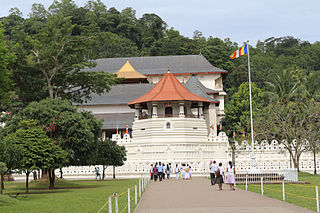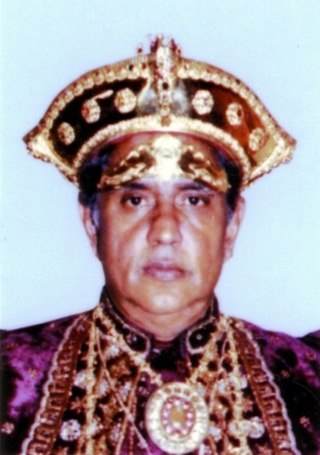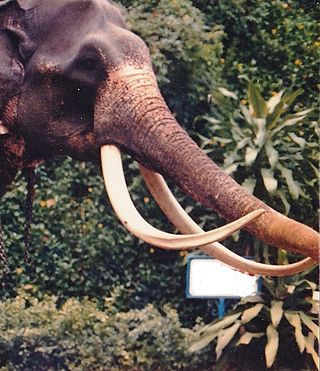
Kandy is a major city in Sri Lanka located in the Central Province. It was the last capital of the ancient kings' era of Sri Lanka. The city is situated in the midst of hills in the Kandy plateau, which crosses an area of tropical plantations, mainly tea. Kandy is both an administrative and religious city and the capital of the Central Province. Kandy is the home of the Temple of the Tooth Relic, one of the most sacred places of worship in the Buddhist world. It was declared a World Heritage Site by UNESCO in 1988. Historically the local Buddhist rulers resisted Portuguese, Dutch, and British colonial expansion and occupation.
The relic of the tooth of Buddha is venerated in Sri Lanka as a sacred cetiya relic of the Buddha, who is the founder of Buddhism, the fourth largest religion worldwide.

The Kandy Esala Perahera also known as The Festival of the Tooth is a festival held in July and August in Kandy, Sri Lanka. This historical procession is held annually to pay homage to the Sacred Tooth Relic of Buddha housed at the Sri Dalada Maligawa in Kandy. A unique symbol of Sri Lanka, the procession consists of traditional local dances such as fire dances and performances in whip-dance garments. The festival ends with the traditional Diya-kepeema ritual, a water cutting ceremony which is held at the Mahaweli River at Getambe, Kandy.
The Aluth Sahal Mangalle or the New Rice Festival is a harvest festival of the Maha kannaya in Sri Lanka. The first batch of new rice after being plucked, threshed and winnowed is offered to the Buddha and deities.

Deshamanya Nissanka Parakrama Wijeyeratne, known as Nissanka Wijeyeratne, was a Sri Lankan politician, civil servant, diplomat and English language poet. He was also the Diyawadana Nilame of the Sri Dalada Maligawa, Kandy from 1975 to 1985. At the time of death he was serving as the chairman of The Law and Society Trust in Sri Lanka.

Diyawadana Nilame is the office of the chief lay custodian of the Temple of the Tooth, Kandy, Sri Lanka. Formerly an office of the royal household, at present it is the trustee for the Temple of the Tooth as defined by the Buddhist Temporalities Ordinance of 1931. A ceremonial position, enriched with over two thousand years of history to protect and carry out ancient rituals for the relic of the tooth of the Buddha. The Diyawadana Nilame recognised as a states man has the responsibility of overseeing of all aspects of the Sri Dalada Maligawa. He has the traditional duty of organizing the annual pageant, the Kandy Esala Perahera. The current Diyawadana Nilame is Pradeep Nilanga Dela.

Neranjan Priyadarshana Dullewe Wijeyeratne is a Sri Lankan. He was Diyawadana Nilame of the Sri Dalada Maligawa, Kandy for 20 years from 1985 to 2005. Wijeyeratne was former United National Party politician and ex chief organiser for the Galagedara Electorate in Kandy District and former Leader of the Opposition in the Kandy Municipal Council.

Wanigasekara Wanasinghe Mudiyanse Ralahamilage Pradeep Nilanga Dela is the present Diyawadana Nilame or Chief Custodian of Sri Dalada Maligawa and 19th Diyawadana Nilame. He acted as the Basnayake Nilame of Ruhunu Maha Kataragama devalaya and Sabaragamu Maha Saman devalaya, before being elected to the post of Diyawadana Nilame on July 1, 2005.

Sri Dalada Maligawa, commonly known in English as the Temple of the Sacred Tooth Relic, is a Buddhist temple in Kandy, Sri Lanka. It is located in the Royal Palace Complex of the former Kingdom of Kandy, which houses the relic of the tooth of the Buddha. Since ancient times, the relic has played an important role in local politics because it is believed that whoever holds the relic holds the governance of the country. The relic was historically held by Sinhalese kings. The temple of the tooth is a World Heritage Site mainly due to the temple and the relic.
Stanley Wijesundera was a Sri Lankan academic. He served as the first Vice chancellor of the University of Colombo from 1979 to 1988. A Professor of Biochemistry, he was the chairman of the Association of Commonwealth Universities from 1983 to 1984. Professor Wijesundera was assassinated by the JVP Hitman during the 1987–89 JVP Insurrection.

Anuradha Neelendra Dullewe Wijeyeratne is a Sri Lankan politician and entrepreneur, He has served as the acting Diyawadana Nilame of the Sri Dalada Maligawa, Kandy on several occasions for three decades appointed by the Commissioner General of Buddhist Affairs with recommendation from Mahanayaka Theras of the Malwatte and Asgiriya Chapters of Siam Nikaya. He was a Provincial Councillor of the Sabaragamuwa Provincial Council too. In March 2020, he was invited by the United National Party to contest the Parliamentary General Election 2020 and was appointed as the chief organizer for the Mawanella electorate. In 2020 general elections, Wijeyeratne ran unsuccessfully for the Kegalle District seat in Parliament. He is ideologically positioned on the right wing of the United National Party.

Raja was a Sri Lankan tusker elephant belonging to the Sri Dalada Maligawa, Kandy. Raja participated at the annual Esala procession in Kandy for around 50 years and was the sacred casket bearer of the final Randoli perehera for 37 years. He was one of the most celebrated elephants in Asia during his lifetime, and was world famous for his noble behavior. On 20 August 1986 former Sri Lankan President J. R. Jayewardene declared Raja as a national treasure, in recognition of his valuable services to the religion and culture of Sri Lanka.

General Anuruddha Leuke Ratwatte, frequently referred to as Anuruddha Ratwatte, was a Sri Lankan soldier and politician. He was a Cabinet Minister and Deputy Minister of Defence.

1998 Temple of the Tooth attack was an attack on the Temple of the Tooth Relic, located in Kandy, Sri Lanka. The shrine, which is considered to be important to the Buddhists in Sri Lanka, houses the relic of the tooth of the Buddha, and is also a UNESCO designated World Heritage Site. In 1998, it was attacked by Liberation Tigers of Tamil Eelam (LTTE), a separatist militant organization which fought to create an independent Tamil state in Northern and Eastern parts of the country, from 1983 to 2009.

Heiyantuduwa Raja (c. 1924 – 6 November 2002) was a Sri Lankan elephant, which carried the Relic of the tooth of the Buddha casket in the Dalada Perahera for 11 years after the demise of Maligawa Raja. Heiyantuduwa Raja's tusks were each 7 ft 6 in (2.3 m) in length when he was living, and it was considered one of the longest-tusked elephants in the country.

Heen Banda Udurawana was a member of the Senate of Ceylon and Diyawadana Nilame of the Temple of the Tooth, Kandy.

Wijewardena Seneviratne Panditha Abeykoon Bandaranayake Wahala Mudiyanselage Harris Leuke Ratwatte MBE (1900–1964) was a Ceylonese legislator. He was a member of the State Council of Ceylon, Parliament and the Senate of Ceylon. Ratwatte was award the title of Dissawa by the British Governor of Ceylon and was elected as the Diyawadana Nilame of Sri Dalada Maligawa, Kandy.
Kundasale is a former town, now a suburb of Kandy in Kandy District, Central Province of Sri Lanka. The town is situated 7 km (4.3 mi) to the southeast of the centre of Kandy. The population is about 150,000.
Udugama Sri Buddharakkitha Thero was a Sri Lankan Buddhist monk, who was the 20th Mahanayaka of the Asgiriya chapter of Siyam Nikaya. He was presented with the religious title of Agga Maha Pandita by the government of Myanmar on March 7, 2007, in recognition of his contribution to the purification, perpetuation and propagation of Buddhism. His complete title was Most Venerable Agga Maha Panditha Udugama Sddharmakirthi Sri Dhammadassi Rathanapala Buddharakkhithabhidhana Mahanayaka Thero.















